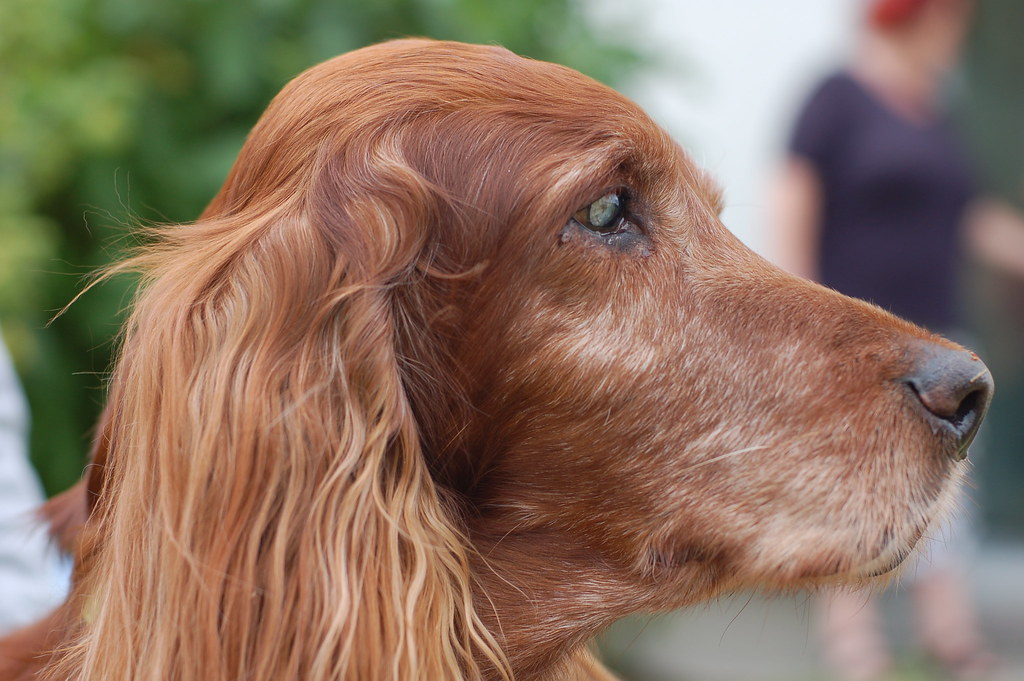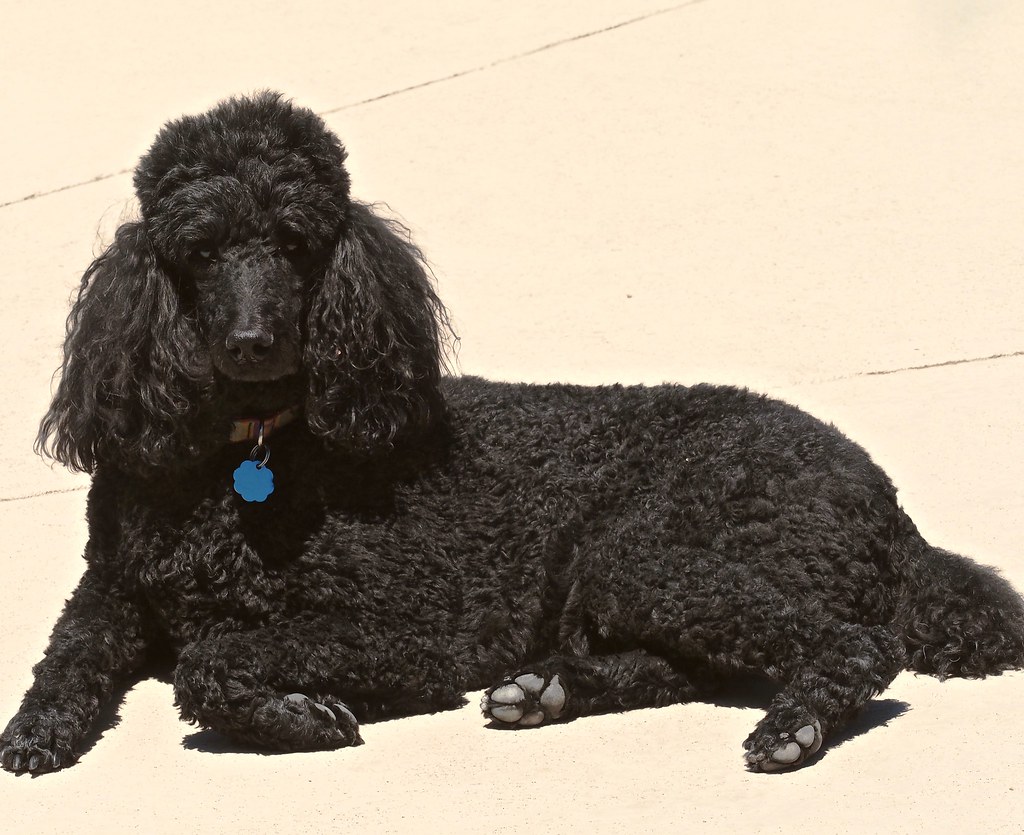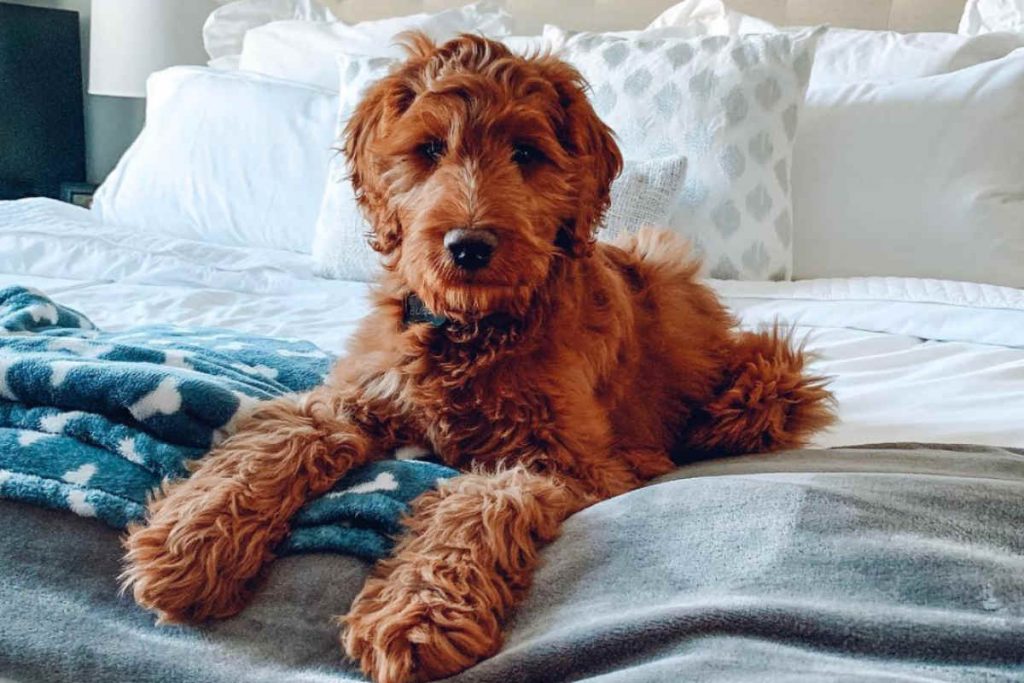A unique blend of Irish Setter and Poodle gives us a distinctive designer breed “The Irish Doodle“. Adored for their eye-catching features and astounding persona that can’t be overlooked, the Irish Doodles are all you need to make your house a home.

This Poodle mix is a complete family dog that loves to spend time with its humans. If you are planning to get an Irish Doodle puppy and looking for a comprehensive guide on the breed, you are in the right place. In this guide, you’ll find everything about Irish Doodle including grooming guide, temperament, training, and health-related issues.
So, let’s explore this fabulous breed- Irish Doodle.
Table of Contents
A fantabulous mix of Irish Setter and Poodle
Irish Doodles didn’t just happen out of nowhere, their parents, Irish Setter and Poodle were crossbred intentionally due to their extraordinary traits.
The Irish setters are renowned for their strikingly sporty nature and desire for companionship. They have always been in trend for their hunting nature. While in comparison, Poodles are fluffy small dogs recognized for their warm nature and outstanding brilliance. They are well known for their low-shedding coats and intelligence.
Both parents outshine other canine breeds due to their skillful hunting characteristics. Irish Doodles; a steady blend of athletic beauty with brains has been created somewhat in the last 30 years in the United States.
Related: Bernedoodle – Golden Mountain Doodle – Sheepadoodle
Introduction to their parent breeds
Irish Setter:

The Irish Setter is a high-energy gundog from Ireland that is famous for its mahogany or rich chestnut red-colored coat. It is a friendly breed that does well with children and other pets (not the small ones). Moreover, it is a highly energetic, active, and playful dog that requires lots of daily exercises and activities. Due to their affectionate and cuddly nature, they are being widely used as therapy dogs in hospitals.
By nature, they are hunting dogs so they may not be an ideal breed if you have an infant and/or small pets at home. They are highly intelligent and have an excellent sense of smell. If you are interested in getting an Irish Setter as a family dog, you need to socialize and train it well.
Poodle:

Poodle, the father of all Doodle breeds is the 7th most popular in the US and the second-most intelligent dog breed in the world. Few people know that Poodles have 5 different types; i.e., Standard Poodle, Miniature Poodle, Toy Poodle, Klein or Moyen Poodle, and Teacup Poodle. The latter 2 are not recognized by AKC and other major Kennel clubs.
Poodles are famous for different traits some of which are their low-shedding coat, trainability, intelligence, affectionate personality, and excellent temperament. All these traits make Poodle an ideal family dog and that is why we see a plethora of Poodle hybrids. Some of the most popular Poodle crosses are Cavapoochon (Cavalier King Charles Spaniel/Poodle/Bichon Frise mix), Goldendoodle (Golden Retriever/Poodle mix), and Shih Poo (Shih Tzu/Poodle mix).
If you are planning to get a dog for the first time and are confused about which breed to get, Poodle is an ideal choice for you.
How many types/sizes are there of Irish Doodle?
There are 2 types of Irish Doodle; Standard Irish Doodle (crossed with Standard Poodle) and Mini Irish Doodle (crossed with Miniature Poodle). The Standard Irish Doodle is a large-sized dog while the Mini Irish Doodle is the smaller one.
Features
Well, that is quite obvious when two contrastingly mesmerizing masterpieces are crossbred, the offspring will carry exuberant genetic traits. Irish Doodle exhibits features that are spot-on and irresistible.
So, we have enlisted the most charismatic features of the Irish Doodle.
- Irish Doodles are famous for their obvious reddish-blonde densely furred coats. But at times, the shaggy fur may be white, black, or brown in color or a blend of these tones. The sleek, wavy texture of the hair adds to its beauty.
- Their dark brown eyes are either oval or almond-shaped and will make your heart melt.
- They have a sporty body with medium height; mostly the size falls between 22 to 28 inches.
- The average Irish doodle weighs between 40 to 70 pounds.
- Their perfectly elongated face is well cohered to their athletic body which is one of their catchiest features.
- The floppy ears fall past the eyes close to their face.
Irish Doodle Pros and Cons
What’s good about them and what’s bad about them? Well, the Irish Doodles have several positive and negative traits that you should know in detail before getting a puppy. Negative doesn’t mean to say bad, but we can say compatibility issues.
Some of the common pros and cons of Irish Doodles are mentioned below.
Pros
Intelligence overloaded:
Both of the Doodle’s parent breeds are highly intelligent and the Irish Doodle inherits intelligence in abundance. So, the Irish Doodle dog is more likely to pick up all the obedience commands without some extraordinary effort.
Low-shedding coat:
Doodle dogs are popular for their low-shedding coats, and similarly, the Irish Doodle also has a low-shedding coat. Still, this trait is unpredictable and totally dependent on the tendency of the parents in puppies.
Ideal family dog:
Apart from its energetic level, it does well with everyone in its family, especially the children. It is affectionate, cuddly, loving, playful, and whatnot. Still, it is recommended to keep your Irish Doodle supervised while it is playing around children and other pets.
Social and friendly:
Irish Doodle is a friendly and loving dog that likes to become the center of attention, so, it is always ready to please others. This party dog is more likely to get along with others, especially your guests.
Excellent therapy dogs:
Last but not least, they are capable of being ideal therapy dogs and can be used in hospitals, schools, and workplaces.
Read: What Makes an Ideal First Aid Kit for Dogs?
Cons
High-energy dogs:
Their parent; the Irish Setters were bred as bird-hunting dogs and have a lot of energy, likewise, the Irish Doodles are also very energetic dogs. They need to be exercised for more than an hour daily which means they are not an ideal breed for a person that cannot give them enough time daily.
Separation anxiety:
They are extreme lovers and if attached to their humans, they do not like to be without them even for a moment which usually leads to separation anxiety. And if they develop separation anxiety, they become destructive and aggressive. You should not get an Irish Doodle if you spend more than 3 hours out of the home OR train them from an early age to stay alone in their kennel when you are away.
High grooming needs:
The low-shedding coats are meant to be brushed and groomed more often in order to avoid matting and tangling. So, as compared to a straight-haired or high-shedding dog, the Irish Setter will need more time for grooming.
Irish Doodle Generations
The Irish Doodle dog comes in several generations. It is all about the tendency, ratio, or percentage of the parent breeds in puppies. So, let’s have a quick look at the generations of Irish Doodles.
F1 Irish Doodle
The first-generation cross between Poodle and the Irish Setter is known as the F1 generation. The F1 generation puppies are 50% Irish Setter and 50% Poodle.
An F1 Irish Doodle may have a low to non-shedding coat but it may still shed a little, after all, it is 50% Irish Doodle which is a shedding breed. Similarly, its coat would be unpredictable as it may have a curly, wavy, or straight coat. So, this generation is good to go for those with mild allergies.
F1b Irish Doodle
Also known as the first-generation backcross, it is a cross between an F1 Irish Doodle and one of the two parent breeds (more likely, a Poodle). An F2b Irish Setter would be 75% Poodle and 25% Irish Setter.
An F1b Irish Doodle has a curlier coat than the F1 which will shed lesser and therefore, is recommended for those with high allergies.
F2 Irish Doodle
The cross between two F1 Irish Doodle dogs is known as the F2 generation. It is also known as the second-generation cross. The difference between the F1 and F2 is that the F1’s parents are Poodle and Irish Setter while the F2’s parents are both F1 Irish Doodles.
F2 puppies are highly unpredictable in terms of coat types and they may have straight, wavy, or curly coats.
F2b Irish Doodle
A cross between an F1 and an F1b Doodle is called an F2b. It is also known as a second-generation backcross. The tendency of both breeds in an F2b cross is 62.5% Poodle and 37.5% Irish Setter.
The F2b Irish Doodle is hard to breed because it may take a long time to develop the perfect blend. But one thing to remember is that their coats are usually among the low-shedding ones and are very popular.
Which one is the best generation of Irish Doodle
In terms of shedding, the F1b is the best with a lower shedding coat and would cost less than an F2b Irish Doodle. It could be a great choice for people with high allergies.
Related: Bernedoodle Generations
Temperament and behavior
The Irish Doodle is a small package with surprising traits that amaze any dog lover. They are the most lovable dogs you will ever come across, so affectionate and loyal to their owners that it will make your heart flutter. These dogs long for companionship to the extent that boredom and isolation will lead to separation anxiety if you leave this dog alone.
They are active and energetic to a time and their battery never dies. So, you need to keep them busy in productive cum adventurous activities, or else they are naughty enough to get you in trouble. If you have an Irish Doodle, you won’t be needing any television or PlayStation because they are always on their paws to keep you entertained.
Being intelligent facilitates them to learn at a speedy pace. They give you the comfort of enjoying the excellent ambiance at your place because of their quiet nature.
Irish Doodle Grooming Guide
Grooming is core to maintaining a dog’s outlook, especially if it’s a Doodle. Brushing their coat is fundamental when dealing with these Doodles because of their double-coated fur.
Wondering, how often do you need to brush your Irish Doodle? Well, it all depends on the thickness of the coat. In hybrid dogs, the coat is unpredictable and it may vary. Anyhow, combing its hair regularly (3-4 times a week if the coat is curlier) is the key to avoiding unwanted knotting and matting. The brushes come in versatile designs including de-matter, comb, de-shedder, and clipper depending on your requisites.
Whilst petting dogs, the fur shedding is something daunting. But in Irish Doodles, you need not worry because they are more likely to have a low-shedding coat. You can clip their hair after every 3-3 months; it will maintain its coat.
Keeping a check on its ears is crucial because of its vulnerability to ear infections, especially if it loves playing in the water. So don’t forget to clean their ears regularly. Last but not least, brush their teeth several times a week to keep them plaque-free.
Related: Things not to do while Grooming your Dog
Living with an Irish Doodle
Irish Doodles are fun to be around. Their endearing nature makes them well-suited for children and elders if trained and socialized appropriately from an early age. Besides family, they learn to live in harmony with other pets at home as well. Though they behave well with strangers and are quiet dogs, they do alarm you when something happens out of the box.
They are ideal dogs for athletes and would be ready to run, jog, hike, swim, and do other activities.
Nutritional Requirements
Never compromise on the food quality whilst feeding your dog. Significantly, the food should cater to all its nutritional requirements promoting its health and performance. You can add dry, wet, or raw food to your dog’s diet depending on its preference.
For a puppy, the best dose to start with is four meals a day in small portions to avoid overburdening its stomach. For adults, you can lessen up to 2 meals a day or more accordingly.
It is also better to take a piece of advice from your vet on your pup’s food.
Training
Patience and commitment are the two virtues that you need to practice while training any dog, and that is true in the Irish Doodle’s case too. At times, Irish Doodles can be challenging to train because they quickly lose their interest so you need to put some variety and rewards in their training sessions. The Irish Doodle lives for physical activity.
First, you need to build a repo with your dog. The training works on the principle of positive reinforcement. Once you learn to work out the communication, the training becomes more straightforward. It would be best if you are interactive and adventurous to keep your dog involved in the activities. These Doodles love to hike, swim, play games, and walk on long trails. They need 90 to 120 minutes of physical activity every day to maintain their sporty physique. They are renowned for their hunting and swimming capabilities.
Health Concerns
When it comes to their health, the Irish doodles are tough and more resilient than their parents because they are crossbreds and are less likely to inherit the genetic issue if bred well. But still, they are prone to health hazards that are common among their parents and other dogs.
Due to genetics, they may suffer from orthopedic issues developing skeletal disorders. They are vulnerable to developing epilepsy, both hip and elbow joint dysplasia – a condition where both joints don’t fit, luxating patella – a situation in which knee caps dislocate from the normal position and eye problems. Therefore, a regular checkup from the vet is a must.
The best practice to avoid such issues is getting a puppy from a well-reputed breeder and not a backyard breeder or a puppy mill.
How much do Irish Doodles cost?
Well, their prices may vary from breeder to breeder and state to state. Usually, an Irish Doodle cost you between $1400 to $4000 depending on the color, gender, the breeder’s reputation, and some other factors.
Along with that, you may be needing to spend between $500 to $800 every year for necessary puppy supplies such as a leash, collar, crate, and vet visits.
Related: Pomsky Dog Breed Info – A Comprehensive Guide
Irish Doodle FAQs
How big is a fully-grown Irish Doodle?
An adult Standard Irish Doodle may stand anywhere about 15 to 27 inches in height and weigh about 35 to 55 lbs. While a Mini Irish Doodle may grow between 12 to 18 inches and weigh between 25 to 35 lbs.
Do Irish Doodles bark a lot?
No, they rarely bark which is why they are considered an ideal family dog. But make sure to train them from an early age or they may develop behavior issues including excessive barking.
Are Irish Doodles completely hypoallergenic?
None of the dogs are completely hypoallergenic and they may shed a little amount of hair. And being a Poodle’s product, the Irish Doodle is more likely to inherit the Poodle’s low-shedding coat and shed very little.
Do Irish Doodles like to cuddle?
Yes, both of their parent breeds are affectionate and like to cuddle their owners. Similarly, the Irish Doodles have no problem cuddling their owners.
Are Irish Doodles different than Golden Irish?
Yes, the Irish Doodle is an Irish Setter Poodle mix while the Golden Irish is a cross between the Golden Retriever and Irish Setter.
My Irish Doodle puppy breaths very fast, should I be worried about it?
Every puppy’s breathing average is greater than an adult dog’s. An adult dog may breathe up to 30 times per minute while a puppy may breathe up to 40 times per minute, and if the puppy is sleeping, it can take even more breaths than the normal rate. So, there is nothing to worry about unless you feel any abnormality in its breathing.
Recognition
Most of the major kennel clubs in the world such as AKC and CKC don’t recognize the Irish Doodle because it is a hybrid dog and they do not recognize any of the mixed breeds. But several kennel clubs recognize hybrid breeds such as the American Canine Hybrid Club ACHC, the Dog Registry of America (DRA), and the International Designer Canine Registry (IDCR).
Summing it up
Nothing is cozier than your dog’s warm snuggles. And Irish Doodles are one of a kind that will give you so much affection and care that it will melt your heart. They live for you, and to your surprise, they are the most loyal family dogs you will come around. So pals, why the wait? Get this unique breed and give your home the warmth and positive vibes it misses.
Recommended read – Bordoodle dog breed info
Image credit: bubba.thedood / Instagram

